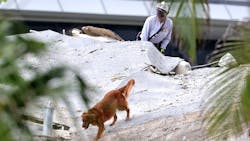FL Firefighters Face Unique Challenges with Condo Collapse
SURFSIDE, FL—The tragic collapse of Champlain Towers South condominium presents Miami-Dade Fire Rescue with search and rescue difficulties as multilayered as the rubble that used to be 12 floors of apartments and a lobby.
“This is the most complex situation we’ve ever encountered,” MDFR Assistant Fire Chief Ray Jadallah told family, friends and loved ones of victims during the Saturday afternoon update filmed by Instagram user abigailpereiraok.
Miami-Dade Fire Rescue has an international accreditation that few departments possess. Their rescue workers get sent to disasters elsewhere. But the department now faces a unique mix of issues that vary from many other calamities.
RELATED:
- At Least One Dead, 99 Missing in FL Condo Partial Collapse
- Miami-Dade USAR Team's History with Global Disasters
- FL Condo Collapse: Death Toll Rises to Four, 159 Missing
- USAR K-9s Searching FL Condo Collapse for Victims, Bodies
- 9 Confirmed Dead, 156 Missing in FL Condo Collapse
“Unlike other buildings, where we could get machinery on all four sides of the building, with this structure, we have soft sand on one end,” Jadallah said. “We have a building on another end. We have another building on another end. We have a building that’s still standing that’s 12 stories high. We’re very limited in number of resources.”
Those concerns limit the large equipment rescue workers can bring into play. Some of the equipment was used to dig the trench. The trench was needed because of the smoke and the fire, which hampered rescue efforts Friday and Saturday.
And still looming over their efforts is the part of the Champlain Towers South that’s still standing — for now.
“The people are doing their best,” said Moises Soffer, a volunteer for five years with the Israeli rescue group Cadena. “The structure was unstable, and that’s why it took time to start working.”
“It’s a very deep fire,” Miami-Dade Major Daniella Levine Cava said Saturday. “It’s extremely difficult to locate the source of the fire. They’ve been working around the clock under the rubble so they can fix it. The smoke has spread laterally. It’s difficult to find the source of the fire, therefore to stop it.”
Blowing away the smoke with large fans or blowers wasn’t an option because, as Jadallah said, “With every action, there’s a reaction. We start pushing the smoke (with air), the oxygen increases the size of the fire.”
In addition to using foam and water to get the fire under control by Saturday evening, rescue workers used the heavy equipment to dig a trench under the rubble that Levine Cava described as 125 feet long, 20 feet wide and 40 feet deep. That confined the smoke and allowed for searching in the non-smoke areas with dogs, cameras, sonar and infrared technology.
Miami-Dade Fire Rescue Chief Alan Cominsky said Saturday afternoon that no new victims had been seen since Friday. But with improved visibility by Saturday evening, rescue workers found victims before Sunday morning.
It was merely closure, not a happy ending: Levine Cava said four bodies had been found along with other unaccounted for human remains.
And rescue workers — only so many of which can be on or among the wreckage at a given moment without creating even more of a danger — continued looking among the piles.
Miami Herald staff writers Bianca Padro Ocasio and David Goodhue contributed to this report.
———
©2021 Miami Herald.
Visit at miamiherald.com.
Distributed by Tribune Content Agency, LLC.
